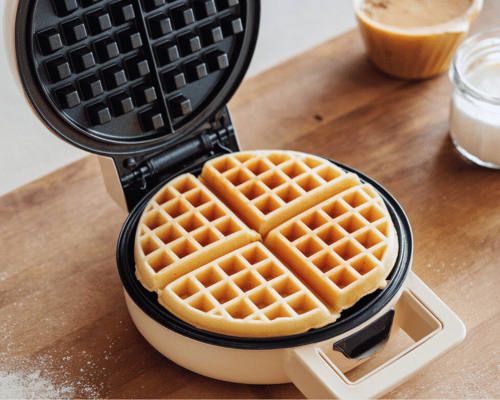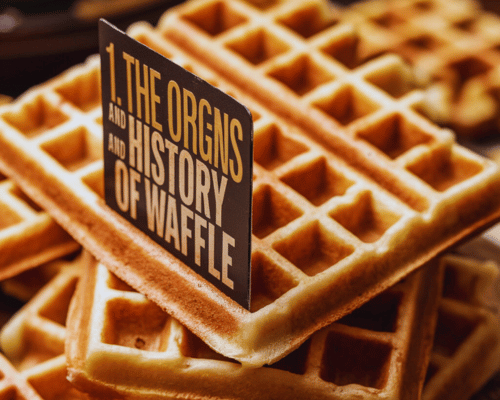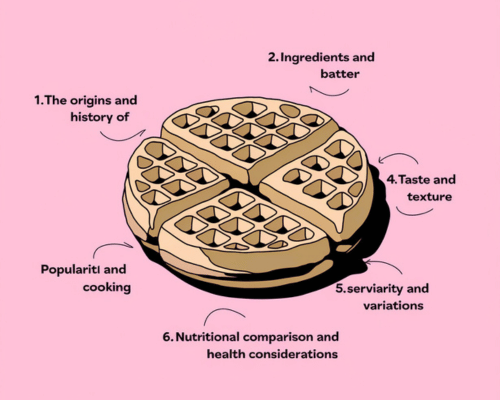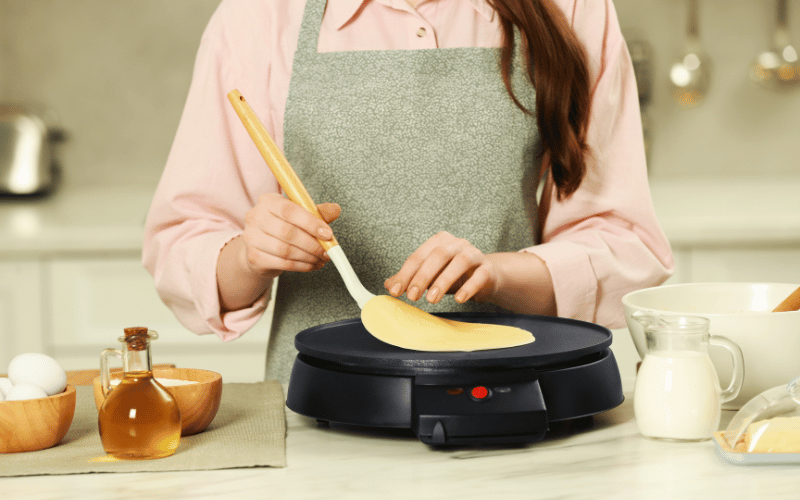A waffle is a dish made of leavened batter and dough. Waffles are a very common breakfast food around the world because they are relatively simple to prepare and can be served with a variety of toppings. But what is the difference between a Belgian Waffle vs Regular Waffle? Basically, a regular waffle is thinner than a Belgian waffle and has less space to fill with butter, jam, or maple syrup. Belgian waffles have a larger and deeper square pocket than a regular waffle. In this article, we will explore the secrets of their ingredients and delve into their history.

The Origins and History of Waffle

Waffle is derived from the Dutch word “wafel”, which means “wafer”. The ancient Greeks cooked flat cakes between two hot plates over an open fire. Eventually, this cooking method spread to medieval Europe and became a popular street food.
In the United States, Thomas Jefferson brought the first waffle iron back from France in the late 18th century. However, Belgian waffles entered the limelight at the 1958 Brussels World’s Fair. A Belgian chef named Maurice Vermersch introduced a light and airy waffle with deep pockets. Those compartments were made to hold strawberries, whipped cream, and other delightful toppings. Belgian waffles have gradually grown to be one of the most well-liked street foods worldwide since that time.
Waffles are very well-liked worldwide, both Belgian and regular. Belgian waffles are celebrated as one of the national dishes and are enjoyed during festivals and other occasions in their home country. At the same time, regular waffles evolved into an essential breakfast in the US.
Belgian waffles are frequently considered a luxury treat and are often served with charming toppings like chocolate, fruit, and whipped cream. On the other hand, regular waffles have a homey appeal and are often paired with butter, fried chicken, or maple syrup.
Yet, all the toppings and recipes might change depending on the cultural context. In Belgium, all the waffle recipes are precious family secrets, and they are passed down through generations. As we explore further, we will learn the components and methods of preparation for those waffle varieties and how historical origins have influenced the shape of the waffles over time.
Ingredients and Batter
Regular and Belgian waffles both have nearly the same ingredients. All-purpose flour, eggs, milk, sugar, vanilla, and butter are the main ingredients for both regular and Belgian waffles. All-purpose flour provides the structure and soft crumb. While regular waffles use whole eggs, Belgian waffles use only egg whites. Milk is used for creating tenderness and moisture; it also improves the flavor of the waffles. Sugar simply sweetens the waffle, and baking powder is needed for the light and airy texture. Vanilla extract infuses the waffle with a fragrant aroma, and butter adds flavor.
Because whole eggs are a regular ingredient in waffles, they have a thick texture. Belgian waffles, on the other hand, have a lighter and airier texture due to the use of beaten egg whites and additional butter.
Preparation and Cooking
A regular waffle and a Belgian waffle may share the same name, but their features and preparation methods are different. Belgian waffle makers are made to produce waffles with deep pockets. They have deeper grids than regular waffle makers, which allows them to create those iconic deep pockets. Belgian waffle makers usually produce larger waffles with round or square shapes, which can contain more toppings. Many of them feature adjustable temperature control and a rotating mechanism. With those particular Belgian waffle makers, you can get the crispiness you want. They do not stick to or rip on metal plates thanks to their non-stick surface, which gives the waffles a perfect shape.
Start by oiling the grids and preheating the waffle maker. Meanwhile, prepare the batter, which primarily includes flour, sugar, milk, baking powder, vanilla extract, and eggs. Do not use the entire egg when making a Belgian waffle. Instead, use beaten egg whites to make a lighter, airier batter. After that, carefully pour the batter onto the preheated waffle maker and make sure not to overfill it.
Next, close the lid and cook until the waffle reaches a golden-brown color and a crisp texture. Carefully remove the waffle from the waffle maker once it is finished. The waffle is now ready to be served with whipped cream, maple syrup, butter, fresh berries, or other toppings of your choice. Remember that you can use a standard waffle maker to make both Belgian and regular waffles (though the results might not be as you had hoped). For a regular waffle and a Belgian waffle, you simply need to adjust the quantities of batter, baking powder, and eggs.
Taste and Texture
Belgian waffles and regular waffles differentiate themselves in taste and texture. Regular waffles have a heartier, denser texture, whereas Belgian waffles are remarkably light. They are incredibly fluffy and delicate due to the use of beaten egg whites. An essential characteristic of Belgian waffles is their crisp exterior, which stands up to rich toppings.
A Belgian waffle has a rich, buttery flavor, while a regular waffle has a more neutral flavor. Because of this, Belgian waffles offer a special treat all their own, while regular waffles let the toppings take center stage. Belgian waffles typically have a hint of sweetness, which improves their appearance. Regular waffles, on the other hand, maintain a denser interior, making them perfect for soaking up syrups and sauces.
Popularity and Variations
Belgian waffles are famous for their versatility and excellent taste. They have a great ability to pair with a wide range of toppings. Some of the most popular Belgian waffles are Liege, Brussels, and Belgian Sundae. Liege waffles are named after the Belgian city of Liege and are popular for their caramelized, crunchy exterior. Brussels waffles are known for their symmetrical grid pattern, and the Belgian Waffle Sundae features toppings of ice cream, whipped cream, and an array of sauces.
On the other hand, regular waffles are simpler, and some of the more well-known varieties, including American, Scandinavian, and Hong Kong waffles, are particularly noteworthy as a regular breakfast food. American Waffles come in various shapes and sizes and are fluffier compared to their European counterparts. In nations like Norway and Sweden, Scandinavian waffles are popular and typically served with lingonberry jam and cream. Hong Kong Waffles, On the other hand, are more eggy, filled with sweet fillings like ice cream or chocolate, and are one of the favorite street foods. Waffle lovers have recently experimented with some variations, including Waffle Cones, Savory Waffles, and Waffle Dessert Tacos.
The majority of waffle fans appreciate Belgian waffles for their airy and melt-in-mouth quality. In contrast, regular waffles are famous for their traditional, homey feel. They are both among the finest breakfast options nowadays.
Nutritional Comparison and Health Considerations
Nutritional considerations are important when it comes to waffles. Both regular and Belgian waffles contain about 300–400 calories, 50–60 grams of carbohydrate, 10-15 grams of fat, 5–10 grams of protein, and typically 10–20 grams of sugar per serving, excluding toppings. They are usually low in fiber as they do not contain whole-grain flour.
For those seeking to manage their weight and blood sugar levels, Both regular and Belgian waffles are less suitable as everyday breakfast options. Despite having a high calorie content, neither Belgian nor regular waffles are sufficient sources of fiber, vitamins, and other essential nutrients. Additionally, excessive amounts of whipped cream, syrup, or sugary spreads are not the best for regulating blood sugar levels and weight. However, toppings like yogurt, fresh fruit, and nuts can provide a decent amount of nutrition. Also, you can enjoy waffles while keeping your diet and blood sugar levels stable by using gluten-free flour blends.
Serving and Presentations
Regular waffles have their own presentation style, while Belgian waffles are often presented in ways that highlight their elegance. Regular waffles are normally smaller in size compared to Belgian waffles. A pat of butter melting on top of the warm waffles and a drizzle of maple syrup are classic combinations for regular waffles. Belgian waffles, on the other hand, are sometimes served with specialized equipment, such as a waffle fork, to improve their appearance. Both of them usually include whipped cream as a topping and can also be combined with fruit compote, like blueberry or strawberry, to add a fruity flavor. Belgian waffles typically have ornate presentations, whereas regular waffles value simplicity.
Final Verdict

In nearly every sector, such as nutrition comparison or ingredients, both regular and Belgian waffles are almost the same, despite the fact that they differ considerably in terms of presentation, flavor, and texture.
Since I like both regular and Belgian waffles, I must be impartial when it comes to my own preferences. However, your own preferences matter most in the scenario between regular and Belgian waffles. Trying both regular and Belgian waffles is always recommended. With an open mind and an empty stomach, explore the world of different waffle varieties and let your palate be the judge.
It’s your turn to choose between the simplicity of regular waffles and the delicate elegance of Belgian waffles.
Some Sources and References for Explorer
If you find this article helpful and want to explore more about waffles, here are some sources and references for you to explore further.
- The Joy of Cooking: A classic cookbook that includes detailed waffle recipes and serving ideas by Irma S. Rombauer.
- Waffle Cookbook Top 50 Waffle Recipes: A complete guide to waffle type, recipes, and serving suggestions by Julie Brooke.
- Will it Waffle?: A history and recipe collection for both regular and Belgian waffles by Daniel Shumski.
- I Love My Waffle Maker: A Book that explores unique waffle toppings from various cultures by Cooknation.
- 150 Best Waffle Maker Recipes: Marilyn Haugen and Jennifer MacKenzie’s extensive collection of waffle recipes.
A waffle is a dish made of leavened batter and dough. Waffles are a very common breakfast food around the world because they are relatively simple to prepare and can be served with a variety of toppings. But what is the difference between a regular waffle and a Belgian waffle? Basically, a regular waffle is thinner than a Belgian waffle and has less space to fill with butter, jam, or maple syrup. Belgian waffles have a larger and deeper square pocket than a regular waffle. In this article, we will explore the secrets of their ingredients and delve into their history.
The Origins and History of Waffle
Waffle is derived from the Dutch word “wafel”, which means “wafer”. The ancient Greeks cooked flat cakes between two hot plates over an open fire. Eventually, this cooking method spread to medieval Europe and became a popular street food.
In the United States, Thomas Jefferson brought the first waffle iron back from France in the late 18th century. However, Belgian waffles entered the limelight at the 1958 Brussels World’s Fair. A Belgian chef named Maurice Vermersch introduced a light and airy waffle with deep pockets. Those compartments were made to hold strawberries, whipped cream, and other delightful toppings. Belgian waffles have gradually grown to be one of the most well-liked street foods worldwide since that time.
Waffles are very well-liked worldwide, both Belgian and regular. Belgian waffles are celebrated as one of the national dishes and are enjoyed during festivals and other occasions in their home country. At the same time, regular waffles evolved into an essential breakfast in the US.
Belgian waffles are frequently considered a luxury treat and are often served with charming toppings like chocolate, fruit, and whipped cream. On the other hand, regular waffles have a homey appeal and are often paired with butter, fried chicken, or maple syrup.
Yet, all the toppings and recipes might change depending on the cultural context. In Belgium, all the waffle recipes are precious family secrets, and they are passed down through generations. As we explore further, we will learn the components and methods of preparation for those waffle varieties and how historical origins have influenced the shape of the waffles over time.
Ingredients and Batter
Regular and Belgian waffles both have nearly the same ingredients. All-purpose flour, eggs, milk, sugar, vanilla, and butter are the main ingredients for both regular and Belgian waffles. All-purpose flour provides the structure and soft crumb. While regular waffles use whole eggs, Belgian waffles use only egg whites. Milk is used for creating tenderness and moisture; it also improves the flavor of the waffles. Sugar simply sweetens the waffle, and baking powder is needed for the light and airy texture. Vanilla extract infuses the waffle with a fragrant aroma, and butter adds flavor.
Because whole eggs are a regular ingredient in waffles, they have a thick texture. Belgian waffles, on the other hand, have a lighter and airier texture due to the use of beaten egg whites and additional butter.
Preparation and Cooking
A regular waffle and a Belgian waffle may share the same name, but their features and preparation methods are different. Belgian waffle makers are made to produce waffles with deep pockets. They have deeper grids than regular waffle makers, which allows them to create those iconic deep pockets. Belgian waffle makers usually produce larger waffles with round or square shapes, which can contain more toppings. Many of them feature adjustable temperature control and a rotating mechanism. With those particular Belgian waffle makers, you can get the crispiness you want. They do not stick to or rip on metal plates thanks to their non-stick surface, which gives the waffles a perfect shape.
Start by oiling the grids and preheating the waffle maker. Meanwhile, prepare the batter, which primarily includes flour, sugar, milk, baking powder, vanilla extract, and eggs. Do not use the entire egg when making a Belgian waffle. Instead, use beaten egg whites to make a lighter, airier batter. After that, carefully pour the batter onto the preheated waffle maker and make sure not to overfill it.
Next, close the lid and cook until the waffle reaches a golden-brown color and a crisp texture. Carefully remove the waffle from the waffle maker once it is finished. The waffle is now ready to be served with whipped cream, maple syrup, butter, fresh berries, or other toppings of your choice. Remember that you can use a standard waffle maker to make both Belgian and regular waffles (though the results might not be as you had hoped). For a regular waffle and a Belgian waffle, you simply need to adjust the quantities of batter, baking powder, and eggs.
Taste and Texture
Belgian waffles and regular waffles differentiate themselves in taste and texture. Regular waffles have a heartier, denser texture, whereas Belgian waffles are remarkably light. They are incredibly fluffy and delicate due to the use of beaten egg whites. An essential characteristic of Belgian waffles is their crisp exterior, which stands up to rich toppings.
A Belgian waffle has a rich, buttery flavor, while a regular waffle has a more neutral flavor. Because of this, Belgian waffles offer a special treat all their own, while regular waffles let the toppings take center stage. Belgian waffles typically have a hint of sweetness, which improves their appearance. Regular waffles, on the other hand, maintain a denser interior, making them perfect for soaking up syrups and sauces.
Popularity and Variations
Belgian waffles are famous for their versatility and excellent taste. They have a great ability to pair with a wide range of toppings. Some of the most popular Belgian waffles are Liege, Brussels, and Belgian Sundae. Liege waffles are named after the Belgian city of Liege and are popular for their caramelized, crunchy exterior. Brussels waffles are known for their symmetrical grid pattern, and the Belgian Waffle Sundae features toppings of ice cream, whipped cream, and an array of sauces.
On the other hand, regular waffles are simpler, and some of the more well-known varieties, including American, Scandinavian, and Hong Kong waffles, are particularly noteworthy as a regular breakfast food. American Waffles come in various shapes and sizes and are fluffier compared to their European counterparts. In nations like Norway and Sweden, Scandinavian waffles are popular and typically served with lingonberry jam and cream. Hong Kong Waffles, On the other hand, are more eggy, filled with sweet fillings like ice cream or chocolate, and are one of the favorite street foods. Waffle lovers have recently experimented with some variations, including Waffle Cones, Savory Waffles, and Waffle Dessert Tacos.
The majority of waffle fans appreciate Belgian waffles for their airy and melt-in-mouth quality. In contrast, regular waffles are famous for their traditional, homey feel. They are both among the finest breakfast options nowadays.
Nutritional Comparison and Health Considerations
Nutritional considerations are important when it comes to waffles. Both regular and Belgian waffles contain about 300–400 calories, 50–60 grams of carbohydrate, 10-15 grams of fat, 5–10 grams of protein, and typically 10–20 grams of sugar per serving, excluding toppings. They are usually low in fiber as they do not contain whole-grain flour.
For those seeking to manage their weight and blood sugar levels, Both regular and Belgian waffles are less suitable as everyday breakfast options. Despite having a high-calorie content, neither Belgian nor regular waffles are sufficient sources of fiber, vitamins, and other essential nutrients. Additionally, excessive amounts of whipped cream, syrup, or sugary spreads are not the best for regulating blood sugar levels and weight. However, toppings like yogurt, fresh fruit, and nuts can provide a decent amount of nutrition. Also, you can enjoy waffles while keeping your diet and blood sugar levels stable by using gluten-free flour blends.
Serving and Presentations
Regular waffles have their own presentation style, while Belgian waffles are often presented in ways that highlight their elegance. Regular waffles are normally smaller in size compared to Belgian waffles. A pat of butter melting on top of the warm waffles and a drizzle of maple syrup are classic combinations for regular waffles. Belgian waffles, on the other hand, are sometimes served with specialized equipment, such as a waffle fork, to improve their appearance. Both of them usually include whipped cream as a topping and can also be combined with fruit compote, like blueberry or strawberry, to add a fruity flavor. Belgian waffles typically have ornate presentations, whereas regular waffles value simplicity.
Final Verdict
In nearly every sector, such as nutrition comparison or ingredients, both regular and Belgian waffles are almost the same, despite the fact that they differ considerably in terms of presentation, flavor, and texture.
Since I like both regular and Belgian waffles, I must be impartial when it comes to my own preferences. However, your own preferences matter most in the scenario between regular and Belgian waffles. Trying both regular and Belgian waffles is always recommended. With an open mind and an empty stomach, explore the world of different waffle varieties and let your palate be the judge.
It’s your turn to choose between the simplicity of regular waffles and the delicate elegance of Belgian waffles.
Belgian Waffle vs Regular Waffle: A Delicious Showdown
Some Sources and References for Explorer
If you find this article helpful and want to explore more about waffles, here are some sources and references for you to explore further.
- The Joy of Cooking: A classic cookbook that includes detailed waffle recipes and serving ideas by Irma S. Rombauer.
- Waffle Cookbook Top 50 Waffle Recipes: A complete guide to waffle type, recipes, and serving suggestions by Julie Brooke.
- Will it Waffle?: A history and recipe collection for both regular and Belgian waffles by Daniel Shumski.
- I Love My Waffle Maker: A Book that explores unique waffle toppings from various cultures by Cooknation.
- 150 Best Waffle Maker Recipes: Marilyn Haugen and Jennifer MacKenzie’s extensive collection of waffle recipes

Hey There, I’m Monica, Mom of two. This is my personal blog site. Here I write about Kitchen Tips Tricks, Recipes, and Review the products I use.
I hope you enjoy the article. Give me feedback on how I’m doing with my blog. I would appreciate it so much.
Have a great day! 🙂
[Follow me on Twitter]


